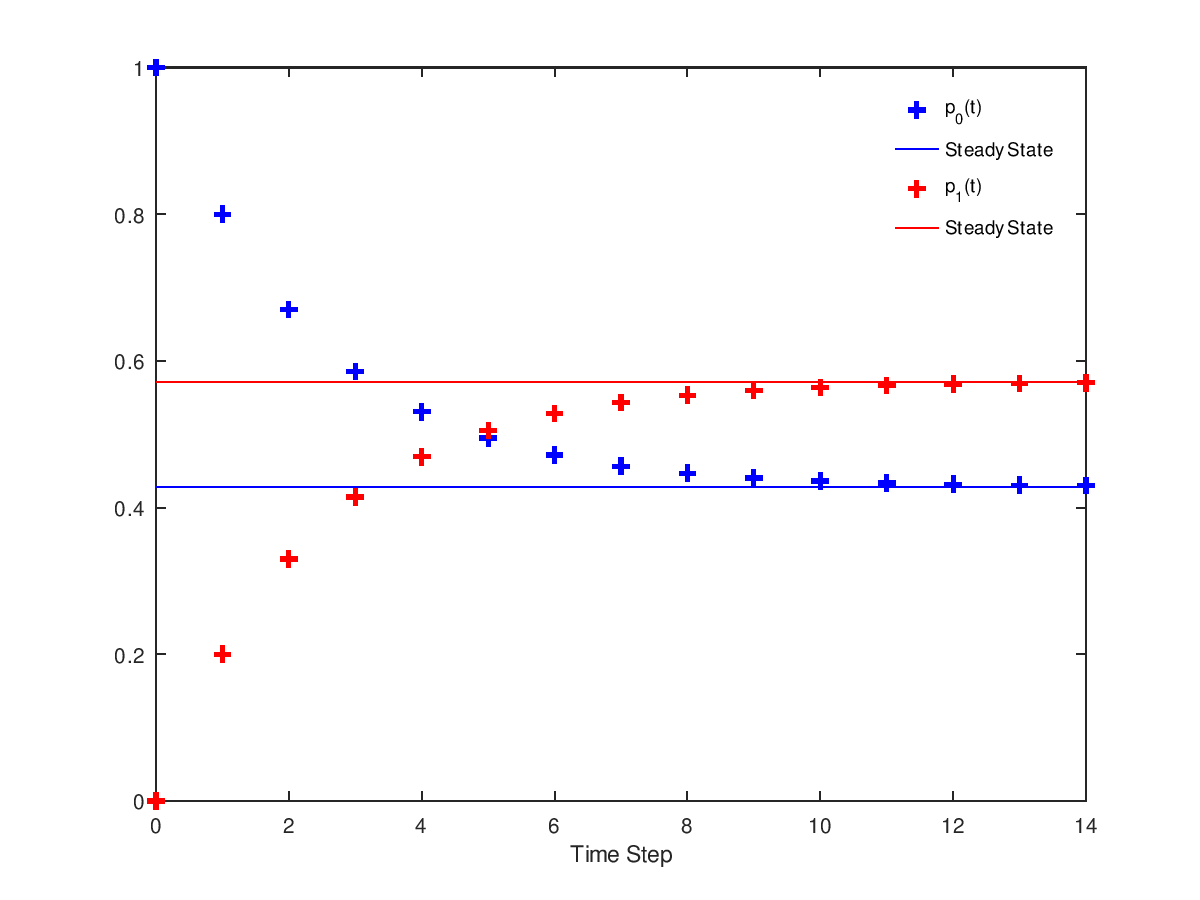- Function File: p = dtmc (P)
- Function File: p = dtmc (P, n, p0)
-
Compute stationary or transient state occupancy probabilities for a discrete-time Markov chain.
With a single argument, compute the stationary state occupancy probabilities
p(1), …, p(N)for a discrete-time Markov chain with finite state space {1, …, N} and with N \times N transition matrix P. With three arguments, compute the transient state occupancy probabilitiesp(1), …, p(N)that the system is in state i after n steps, given initial occupancy probabilities p0(1), …, p0(N).INPUTS
P(i,j)transition probabilities from state i to state j. P must be an N \times N irreducible stochastic matrix, meaning that the sum of each row must be 1 (\sum_{j=1}^N P_{i, j} = 1), and the rank of P must be N.
nNumber of transitions after which state occupancy probabilities are computed (scalar, n ≥ 0)
p0(i)probability that at step 0 the system is in state i (vector of length N).
OUTPUTS
p(i)If this function is called with a single argument,
p(i)is the steady-state probability that the system is in state i. If this function is called with three arguments,p(i)is the probability that the system is in state i after n transitions, given the probabilitiesp0(i)that the initial state is i.
See also: ctmc.
Demonstration 1
The following code
P = zeros(9,9); P(1,[2 4] ) = 1/2; P(2,[1 5 3] ) = 1/3; P(3,[2 6] ) = 1/2; P(4,[1 5 7] ) = 1/3; P(5,[2 4 6 8]) = 1/4; P(6,[3 5 9] ) = 1/3; P(7,[4 8] ) = 1/2; P(8,[7 5 9] ) = 1/3; P(9,[6 8] ) = 1/2; p = dtmc(P); disp(p)
Produces the following output
Columns 1 through 7: 0.083333 0.125000 0.083333 0.125000 0.166667 0.125000 0.083333 Columns 8 and 9: 0.125000 0.083333
Demonstration 2
The following code
a = 0.2;
b = 0.15;
P = [ 1-a a; b 1-b];
T = 0:14;
pp = zeros(2,length(T));
for i=1:length(T)
pp(:,i) = dtmc(P,T(i),[1 0]);
endfor
ss = dtmc(P); # compute steady state probabilities
plot( T, pp(1,:), "b+;p_0(t);", "linewidth", 2, ...
T, ss(1)*ones(size(T)), "b;Steady State;", ...
T, pp(2,:), "r+;p_1(t);", "linewidth", 2, ...
T, ss(2)*ones(size(T)), "r;Steady State;" );
xlabel("Time Step");
legend("boxoff");
Produces the following figure
Columns 1 through 7: 0.083333 0.125000 0.083333 0.125000 0.166667 0.125000 0.083333 Columns 8 and 9: 0.125000 0.083333
| Figure 1 |
|---|
 |
Package: queueing